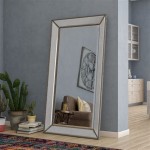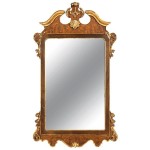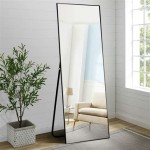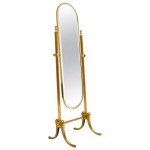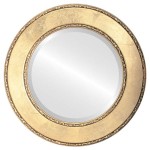How To Bevel a Mirror Edge: A Step-by-Step Guide
Beveling a mirror edge is a process that involves grinding a sloping edge onto the glass, creating a decorative and visually appealing effect. This technique is often employed to enhance the aesthetic value of mirrors, adding depth and dimension. While the process requires specialized tools and a degree of skill, understanding the steps involved can allow individuals to achieve professional-looking results. This article provides a comprehensive guide on how to bevel a mirror edge, outlining the necessary equipment, safety precautions, and step-by-step instructions.
Before embarking on the beveling process, it is crucial to gather the appropriate tools and materials. A dedicated glass beveling machine is the primary piece of equipment. These machines are designed to hold the mirror securely and precisely control the grinding process. Alternatively, a flat lap grinder with diamond grinding wheels can be used, although this method requires more manual control and can be more challenging for beginners. A selection of diamond grinding wheels with varying grits is essential. Coarse grits are used for initial material removal, while finer grits are used for polishing the beveled edge. Safety glasses, gloves, and a dust mask or respirator are indispensable for protecting oneself from glass shards and dust. Water is required as a coolant and lubricant during the grinding process. Finally, a soft cloth or sponge and glass cleaner are necessary for cleaning the mirror and the beveled edge.
Safety First: Essential Precautions When Beveling Glass
Working with glass involves inherent risks, and safety should always be the top priority. Before commencing the beveling process, ensure a clear understanding of the potential hazards and implement the necessary safety measures. The primary risk is exposure to glass shards, which can cause cuts and abrasions. Safety glasses should be worn at all times to protect the eyes from flying debris. Gloves are essential for protecting the hands from cuts and irritation caused by prolonged contact with water and abrasive materials. A dust mask or respirator is crucial for preventing the inhalation of glass dust, which can be harmful to the respiratory system. It is also important to work in a well-ventilated area to minimize dust concentration. Always inspect the mirror for any existing cracks or chips before beginning the beveling process. Attempting to bevel a damaged mirror can increase the risk of breakage. Regularly clean the work area to remove glass debris and water spills, which can create slip hazards. Remember to disconnect the beveling machine from the power source before performing any maintenance or cleaning tasks. Following these safety precautions diligently will significantly reduce the risk of injury during the beveling process.
The beveling process involves several stages, each requiring careful attention to detail. The first step is to prepare the mirror. This involves thoroughly cleaning the edges of the mirror to remove any dirt, grease, or fingerprints. A clean surface will ensure optimal adhesion of the grinding wheels and prevent contaminants from interfering with the beveling process. Once the mirror is clean, it should be securely mounted on the beveling machine or flat lap grinder. Ensure that the mirror is properly aligned and that it is held firmly in place to prevent movement during grinding.
The next stage is the rough grinding phase. This is where the bulk of the material is removed to create the initial bevel angle. Select a coarse-grit diamond grinding wheel and attach it to the machine. Turn on the water supply to provide continuous cooling and lubrication. Gently press the mirror edge against the rotating grinding wheel, maintaining a consistent angle. Move the mirror smoothly and evenly across the wheel, avoiding excessive pressure, which can cause chipping or cracking. Regularly inspect the bevel to ensure that the desired angle and width are being achieved. This process requires patience and control. Repeat the rough grinding process until the bevel reaches the desired dimensions. Be aware of the heat generated, as excessive heat can damage the mirror and grinding wheel.
After the rough grinding phase, the next step is the fine grinding process. This stage involves using progressively finer-grit diamond grinding wheels to smooth the beveled edge and remove any scratches or imperfections left by the coarse-grit wheel. Replace the coarse-grit wheel with a medium-grit wheel and repeat the grinding process, using lighter pressure and slower movements. Continue to use water as a coolant and lubricant. After the medium-grit wheel, switch to a fine-grit wheel and repeat the process again. The goal of the fine grinding phase is to create a smooth, uniform surface that is ready for polishing. Regularly clean the mirror and the grinding wheels to remove any debris that could contaminate the polishing process.
Mastering the Grinding Wheel: Choosing and Using the Right Grit
The selection and proper use of diamond grinding wheels are critical to achieving a successful bevel. Diamond grinding wheels are available in a range of grits, each designed for a specific purpose. Coarse-grit wheels (e.g., 60-120 grit) are used for initial material removal and shaping the bevel. These wheels have a high abrasive power and can quickly remove glass, but they also leave behind a rough surface. Medium-grit wheels (e.g., 220-400 grit) are used for refining the bevel and removing scratches left by the coarse-grit wheel. These wheels provide a smoother surface and prepare the glass for finer polishing. Fine-grit wheels (e.g., 600-1200 grit) are used for final smoothing and polishing, creating a near-polished surface. These wheels have a low abrasive power but produce a very smooth and refined finish. The choice of grit depends on the desired level of smoothness and the type of mirror being beveled.
When using diamond grinding wheels, it is important to maintain proper lubrication and cooling. Water is the most common coolant and lubricant used in glass beveling. It helps to dissipate heat, prevent the grinding wheel from clogging, and remove glass debris. A constant stream of water should be directed onto the grinding wheel and the mirror edge during the grinding process. Avoid using excessive pressure when grinding, as this can cause the grinding wheel to wear out prematurely and can damage the mirror. Instead, use light, even pressure and allow the grinding wheel to do the work. Regularly inspect the grinding wheels for wear and tear. If the wheels become worn or damaged, they should be replaced. Clean the grinding wheels periodically to remove any accumulated glass debris. Following these guidelines will help to ensure that the diamond grinding wheels last longer and perform optimally.
The final stage of the beveling process is polishing. This step is essential for creating a clear, reflective bevel. Apply a polishing compound to a polishing wheel. This wheel is typically made of felt or a similar soft material. Gently press the beveled edge against the rotating polishing wheel, maintaining a consistent angle. Move the mirror smoothly and evenly across the wheel, using light pressure. The polishing compound will remove any remaining scratches and imperfections, creating a smooth, reflective surface. Regularly inspect the beveled edge to ensure that it is being polished evenly. If necessary, apply additional polishing compound. The polishing process may take some time, depending on the type of mirror and the desired level of polish.
After the polishing process is complete, clean the mirror thoroughly with glass cleaner and a soft cloth. Inspect the beveled edge for any remaining imperfections. If necessary, repeat the polishing process. Once the beveled edge is clean and polished to the desired level, the mirror is ready for use. With proper care and maintenance, a beveled mirror edge can last for many years. The key is to use the right tools and materials, follow the safety precautions, and take the time to do the job properly.
Troubleshooting Common Beveling Issues: Chips, Scratches, and Unevenness
During the beveling process, several issues can arise that may compromise the quality of the finished product. One common problem is chipping along the edge of the bevel. This can be caused by using excessive pressure during grinding, using a dull grinding wheel, or working with a mirror that has pre-existing flaws. To prevent chipping, use light, even pressure, ensure that the grinding wheels are sharp, and carefully inspect the mirror for any existing damage before beginning the beveling process.
Another common issue is scratches on the beveled surface. These can be caused by using a coarse-grit grinding wheel for too long, failing to properly clean the mirror and grinding wheels, or using contaminated polishing compounds. To prevent scratches, use progressively finer-grit grinding wheels, thoroughly clean the mirror and grinding wheels before each stage of the process, and use only clean, high-quality polishing compounds.
Unevenness in the bevel is another potential problem. This can be caused by inconsistent pressure during grinding, misalignment of the mirror on the beveling machine, or variations in the hardness of the glass. To prevent unevenness, maintain consistent pressure, ensure that the mirror is properly aligned, and use a high-quality beveling machine that provides precise control over the grinding process. If any of these issues arise, it is important to address them promptly to prevent further damage. In some cases, it may be necessary to start the beveling process over again. With practice and attention to detail, these issues can be minimized, and a high-quality, professional-looking beveled mirror edge can be achieved.
The information presented provides a foundation for understanding the process. With practice and careful attention to detail, individuals can successfully bevel mirror edges, enhancing the aesthetic of their projects.

Mirrors With Bevel Edge Ord Ma Area Glass Co Home Auto Commercial

Bevel Edge Mirror Diffe Sizes Melbourne Bathroom

Buy Bevel Edge Mirror 900x900 In Helmex

Bevel Edge Mirror 1500 X 900 Bathrooms On A Budget

Better Bevel 24 In W X 36 H Frameless Rectangular Beveled Edge Bathroom Vanity Mirror 17110 The Home Depot

Glass And Mirror Edges Made2measure

Guide To Glass Mirrors All Purpose Glazing

Budget Bevel Edge Bathroom Mirror Range Luxe Mirrors

Bevel Edge Wall Mirror 120x75cm Bathroom Mirrors Perth

Beveled Edge Collage Decoration Wall Mirror For Living Room



